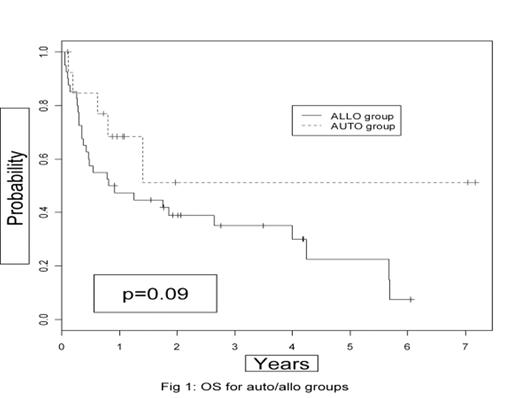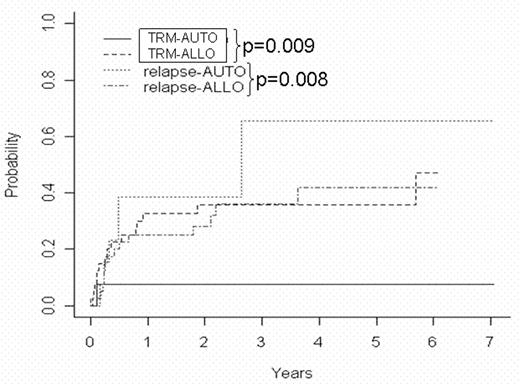Abstract
No reports compare autologous and allogeneic stem cell transplantation (auto-SCT vs allo-SCT) for patients (pts) with relapsed (REL) composite low and intermediate grade non-Hodgkin lymphoma (L/I-NHL). Fifty four pts with composite L/I-NHL (30 transformed, 16 composite(same site), 8 discordant(different sites)) who underwent allo (n=40) or auto-SCT (n=14) from Jan ‘89 to June ‘05 were evaluated (Table 1) to compare long-term results.
Twenty pts (37%) (11/40 allo and 9/14 auto) are alive with median follow-up of 32 months (range 10–87). The 2 and 5-y OS for the whole group were 43% [95% confidence interval: 28–56%] and 29% [14–46%] respectively; the 2 and 5-y EFS 40% [26–53%] and 24% [11–39 %]. 5-y OS for the auto and allo-SCT were 51% and 23% respectively (p=.09)(Fig. 1). The 2 and 5-y EFS for the allo vs auto-SCT groups were 36% [24–55%] vs 54% [33–89%] and 27% vs 23% (p=0.4).
Thirty four pts (63%) died; 18 (33%) with REL NHL and 16 (30%) with TRM. TRM was due to GVHD (n=7), infection (n=6), cerebral edema (n=1) and veno-occlusive disease (n=1). All but one (cerebral edema) TRM deaths occurred post allo-SCT. The cumulative incidence (CI) of TRM and REL for the whole group were 37% [17–57%] and 47% [30–64%]. The CI of TRM for allo and auto-SCT were 47% [20–74] and 8% [0–23%] respectively (p=.009)(Fig. 2).
Twenty pts (37%) relapsed post SCT (14/40, 35% allo and 6/14, 43% auto). CI of REL NHL for allo and auto-SCT were 42% [23–61%] and 65% (p=.008)(Fig. 2).
In conclusion EFS for composite L/I-NHL is low post auto-SCT due to a high relapse rate despite acceptable TRM. While relapse risk is significantly lower post allo-SCT, this advantage is offset by a higher TRM in these pts. Future attempts to reduce TRM while preserving the allogeneic graft vs lymphoma effect may be beneficial.
The clinicopathological characteristics of 54 patients treated with auto and allo-SCT for relapsed composite L/I-NHL
| Parameter . | Allo-SCT n=40(%) . | Auto-SCT n=14(%) . |
|---|---|---|
| * at diagnosis | ||
| Age: Range (Median) | 28–57(44) | 25–59(49) |
| M:F | 2:1 | 1.3:1 |
| Diagnosis | ||
| Transformed lymph. | 25(63) | 5(36) |
| Discordant lymph. | 7(17) | 1(7) |
| Composite lymph. | 8(20) | 8(57) |
| Initial Stage | ||
| I/II | 4(10) | 6(42) |
| III/IV | 36(90) | 8(58) |
| B symptoms* | 11(28) | 6(43) |
| BM involvement* | 29(73) | 3(21) |
| IPI* | ||
| 0–1 | 18(45) | 11(79) |
| 2–3 | 21(53) | 3(21) |
| 4–5 | 1(2) | 0 |
| Prior treatment | ||
| CHOP | 33(83) | 14(100) |
| Purine analogue | 17(43) | 2(14) |
| Rituximab | 12(30) | 6(43) |
| Parameter . | Allo-SCT n=40(%) . | Auto-SCT n=14(%) . |
|---|---|---|
| * at diagnosis | ||
| Age: Range (Median) | 28–57(44) | 25–59(49) |
| M:F | 2:1 | 1.3:1 |
| Diagnosis | ||
| Transformed lymph. | 25(63) | 5(36) |
| Discordant lymph. | 7(17) | 1(7) |
| Composite lymph. | 8(20) | 8(57) |
| Initial Stage | ||
| I/II | 4(10) | 6(42) |
| III/IV | 36(90) | 8(58) |
| B symptoms* | 11(28) | 6(43) |
| BM involvement* | 29(73) | 3(21) |
| IPI* | ||
| 0–1 | 18(45) | 11(79) |
| 2–3 | 21(53) | 3(21) |
| 4–5 | 1(2) | 0 |
| Prior treatment | ||
| CHOP | 33(83) | 14(100) |
| Purine analogue | 17(43) | 2(14) |
| Rituximab | 12(30) | 6(43) |
Figure
Disclosure: No relevant conflicts of interest to declare.
Author notes
Corresponding author



This feature is available to Subscribers Only
Sign In or Create an Account Close Modal